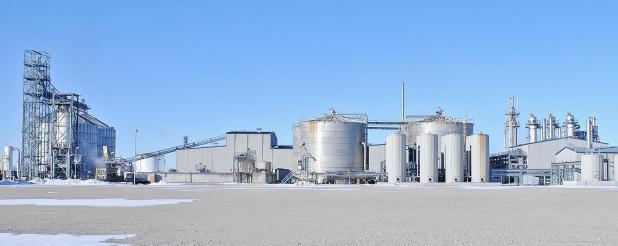
The ethanol plant in Madrid recognized its 12th anniversary of operation in September. During that time, they have purchased more than 200 million bushels of corn.
Outside factors affecting ethanol industry
Perkins County certainly understands the impact ethanol makes on this region and Nebraska as a whole.
Not only does having an ethanol plant within its borders at Madrid enhance corn marketing options, the wages and trickle-down impact of the plant’s presence looms large.
The ethanol industry in Nebraska has come a long ways. In September, Mid America Agri Products/Wheatland L.L.C. celebrated the 12th anniversary of the Madrid plant.
Since 2007, the plant has purchased more than 200 million bushels of corn and sold 570 million gallons of ethanol.
As a state, Nebraska’s 25 plants produced 2.1 billion gallons of ethanol in 2018, compared to 2.2 billion gallons in 2017. That makes Nebraska the second largest producer for corn-based ethanol in the country.
At full capacity, Nebraska plants possess the ability to produce 2.6 billion, according to the Nebraska Ethanol Board.
The state’s ethanol plants have a significant impact on Nebraska’s economy. stable, excellent-paying jobs, taxes and by helping to build demand for corn.
In 2017, the ethanol industry supported 5,166 jobs overall, with an average salary of $78,300 annually.
This average salary amount is higher than similar jobs in other manufacturing industries. Those dollars go a long way in supporting rural Nebraska towns, helping to retain and attract new residents and ensure strong local economies.
Outside factors
But two outside factors raise the biggest concerns for ethanol producers, and in turn, corn producers.
First, there’s the Environment Protection Agency that has granted exemptions to small oil refineries reducing the amount of ethanol they must blend with the gasoline they produce.
Then comes President Trump’s embargo on trade with China.
While the trade issues fall out of the control of the industry, issues with the EPA do not.
The Renewable Fuel Standards Act now requires that 15 billion gallons of ethanol be blended into the U.S. fuel supply.
However, from 2016-2018, the exemptions granted by EPA have reduced that amount by an average of 1.34 billions, or approximately 4.1 billion gallons in total.
Roger Berry, administrator of the Nebraska Ethanol Board, said those reductions have eroded the assurance of 15 billion gallons of demand. As a result, it has curtailed additional investment in the industry.
Even though the Department of Energy says 15 billion gallons of ethanol must be blended, the EPA has ignored that by granting the exemptions, Berry said.
Later this month, the EPA will announce a ruling setting out the renewable volume obligations. In their early draft put out for review, the EPA required that level to be only 770 million gallons.
Berry said that obligation must be at least 1.34 billion gallons to offset the average amount that has been lost due to the small refinery exemptions.
Berry said the 1.34 billion obligation will insure demand for 15 billion gallons of ethanol in accordance with the Renewable Fuel Standards.
Berry submitted testimony asking the EPA to revise their levels to the 1.34 billion.
Their ruling is expected sometime before Christmas.
The ruling also bring political ramifications.
Berry said President Trump can issue an order to require EPA to meet the 1.34 billion gallon threshold if their ruling comes out lower.
By and large, support for President Trump has remained strong in the ag community.
However, if EPA’s standard is lower and President Trump doesn’t take action to raise it, such a move could likely erode his support in the farm belt.
With the 2020 elections coming, it’s also possible that Trump could wait until election season to make the order to gain some political capital.
On the local front
Bob Lundeen, CEO of the Madrid ethanol plant, said the trade embargo and EPA exemptions have forced some plants to slow production or enter maintenance operations.
However, with more plants coming back online following corn harvest, increased production could cut into margins, he noted.
In September, ethanol production dropped to the lowest level for that time of year since 2015, he said.
Lundeen said their 12th anniversary represents a significant achievement, given the turbulent environment of the ethanol industry.
Kevin Sagehorn, vice-president of marketing for Aurora Co-op, said 40 percent of the corn raised in Nebraska goes into ethanol production.
When blending requirements get waived, it reduces the amount of corn consumed, which in turn trickles down the entire ag economy.
It also requires finding additional markets for corn.
Aurora Co-op operated its own 45-million gallon ethanol plant west of Aurora and is a minority partner with Pacific Ethanol in a 110-million gallon plant at the same location.
Sagehorn said the co-op has shut down it’s own plant because it’s an older plant and less efficient than the larger plant.
Aurora Co-op has been a major proponent of ethanol in Nebraska.
They built the A-Stop north of Grant several years ago, which is equipped with ethanol blending pumps.
They offer ethanol blends of 10%, 15%, 30% and 85% with octanes ranging from 87 to 105.
Sagehorn said the A-Stop has made a positive contribution to the use of ethanol blends and diesel.
